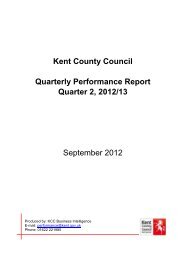Sexualisation of Young People Review
Sexualisation of Young People Review
Sexualisation of Young People Review
Create successful ePaper yourself
Turn your PDF publications into a flip-book with our unique Google optimized e-Paper software.
<strong>Sexualisation</strong> <strong>of</strong> <strong>Young</strong> <strong>People</strong> <strong>Review</strong><br />
Introduction (cont.)<br />
As images that would have been found<br />
shocking just a few years ago flood<br />
the mainstream, so the boundaries<br />
get pushed back further. We’re seeing<br />
adverts that reference gang rape and<br />
adverts where women are reduced<br />
to dismembered body parts. In fact<br />
the influences <strong>of</strong> the iconic visual<br />
constructs <strong>of</strong> porn are contributing to<br />
the emergence <strong>of</strong> a caricature <strong>of</strong> what<br />
it means to be a woman. Being beautiful,<br />
being attractive, being ‘sexy’ is no longer<br />
about individuality and the characteristics<br />
that make a person unique, it’s about<br />
ticking <strong>of</strong>f items on a checklist: big breasts,<br />
big lips, fake tan, fake hair, fake nails – and,<br />
<strong>of</strong> course, youth.<br />
The notion that all young women<br />
who are socialised into believing that<br />
their worth lies in their sexuality and<br />
appearance should have the ‘agency’ to<br />
stand up to these images is naïve. This<br />
assumes that: firstly, all these messages<br />
are assimilated on a conscious level<br />
so can easily be challenged; secondly,<br />
that all young women are afforded the<br />
opportunity to moderate these messages<br />
through healthy parental and peer<br />
relationships; thirdly, that their own selfesteem<br />
is resilient enough to allow them<br />
to question and stand up to prevailing<br />
norms; and finally, that their education has<br />
afforded them the kind <strong>of</strong> media literacy<br />
that allows them to ‘filter out’ unhealthy<br />
messages. The fact is that many young<br />
people don’t have these opportunities<br />
and, as such, are vulnerable to the<br />
messages both overt and covert that are<br />
propagated in the world around them.<br />
With a tendency to ‘adultify’<br />
children and ‘infantilise’ women, the<br />
lines where childhood ends and<br />
adulthood begins are becoming<br />
increasingly blurred. Girls who haven’t<br />
even developed secondary sex<br />
characteristics are posed to look overtly<br />
sexy, while adult women are posed to<br />
look submissive and child-like rather<br />
than empowered and in control. It’s no<br />
surprise therefore that for young female<br />
actors and musicians, taking their clothes<br />
<strong>of</strong>f has become a rite <strong>of</strong> passage, a way<br />
<strong>of</strong> showing the world that they’re ‘all<br />
grown up now’. While boys are ‘allowed’<br />
to enter adulthood without needing<br />
to advertise their sexual availability or<br />
desirability, they are nevertheless exposed<br />
to messages that reinforce the idea that<br />
they should be primarily motivated by<br />
sex and that male desire is something<br />
that cannot be controlled. This is having<br />
an impact both on boys’ attitudes to their<br />
own bodies and on their attitudes to and<br />
behaviour towards girls.<br />
The following section provides an<br />
overview <strong>of</strong> how the media and<br />
advertisers are promoting sexualised<br />
images and messages and explores the<br />
role <strong>of</strong> the internet. It also looks at the<br />
role <strong>of</strong> parents in providing support<br />
to help their children understand and<br />
contextualise what they see and hear.<br />
It goes on to look at the various ways<br />
in which pornography has entered<br />
the mainstream, including through<br />
the internet and the proliferation<br />
<strong>of</strong> lapdancing clubs. Throughout,<br />
we consider the implications <strong>of</strong> this<br />
exposure on children and young people’s<br />
emotional and cognitive development.<br />
34

















